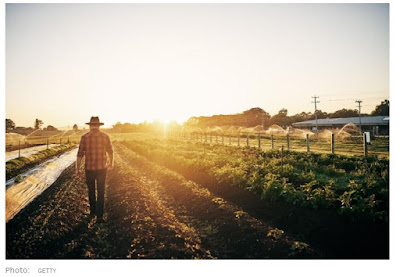According to the World Food Program (via KPMG), 821 million people -- nearly 1 in 9 on the planet -- go to bed on an empty stomach. At the same time, the UN’s Food and Agriculture Organization reports that around 14% of the world's food is lost before reaching the retail level -- this can happen in on-farm activities, storage and transportation.
So, on one hand we have nearly a billion people who are hungry, and on the other we have mountains of perfectly decent food that gets ruined or discarded. And in the middle of these two poles, we have a simple, easily accessed technology that innovators can use to build a bridge between them. That technology is blockchain.
The End Of Inefficiency
In the industrialized world, food follows a complicated supply chain from harvest, slaughter or catch until it reaches the market and our plates. Food loss occurs anytime that food is discarded, disposed of or ruined as it makes its way along this chain. The key issue at hand is that global food loss does not occur because of deficiency in supply. Many say that the Earth produces more than enough food to feed all of its inhabitants. I believe food loss occurs because of inefficiency.
Much has been written about the endemic inefficiencies and opacity of the global food value chain. And these are not just stumbling blocks to alleviating world hunger. They can also exacerbate agriculture’s unnecessarily high carbon footprint and massive water usage. And they may also increase the frequency of contamination that causes food-borne disease and expensive product recalls.
Despite this, food loss due to inefficiency has garnered relatively little attention. According to one paper, 95% of agricultural research over the past 30 years has been focused on raising productivity, and only 5% has been dedicated to reducing losses.
In an age of increasing transparency in business, government and society, one has to wonder: Why is the food-value chain still so opaque? Why is there so little focus on sustainable food loss mitigation?
As the cofounder of a tech company that's working to address these problems, I believe the answer is more about the interests of the industry than actual capabilities for production.
A Secondary Industry
Chugging just beneath the massive food industry are efforts to reduce the food loss problem. These efforts include the use of fumigation and pesticides. But I believe these efforts are treating the symptoms rather than the disease.
The truth is that the future of a sustainable food ecosystem may depend on how we optimize the supply chain. Rather than continue to skirt the problem of food loss, global food suppliers and tech leaders need to address the systemic inefficiencies at its root. One way they can do this is through blockchain technology.
Using Blockchain To Fight Food Loss
By applying supply-demand algorithms based on consumer behavior and agricultural science to data drawn from advanced sensor technology -- all provenanced by blockchain -- we can predict and preempt the freshness of harvest from field through processing and supply chain stops. Moreover, we can better match supply to demand to avoid the current mismatch between these that leads to food loss.
How would this look? Consider how you could use the blockchain to track a flour producer to verifiably and granularly monitor each shipment of wheat -- when it was harvested, under exactly which conditions it was stored on the farm and during each point in transit, what freshness preservation methods were applied to it, and much more. We can find ways to record each measurement or assessment in the blockchain to result in an inviolate record that's accessible to anyone at any time. That would mean that false storage claims would become significantly harder to create, and hidden freshness manipulations would become significantly easier to discover.
From the demand side, such transparency would mean that our flour producer now has an ironclad assurance of the raw material quality. From the supply side, blockchain-provenanced transparency could quite simply force food suppliers to eliminate inefficiencies in the supply chain. Walmart already plans to use the blockchain to track produce supply chains.
From The Belly To The Bottom Line
Today, I believe we need to extend precision agriculture all the way to the consumer’s plate. It’s not acceptable to leverage advanced technology to minimize yield losses in the field but continue to turn a blind eye to the rest of the food value chain.
This is beginning to happen with an enhanced technology focus on the post-harvest value chain. Companies like AgTrix in Australia and StellaApps in India are taking a bigger-picture approach and leveraging technology to address not just production, but also the business processes that smooth out and track the bumps in the agricultural supply chain.
“Today, each component of an extensive food supply system is being digitalized ... There’s also a big need to increase the labor efficiency of agriculture, the quality of products and supply chain transparency,” noted Dmitry Filatov in an AgFunderNews article. And indeed, digitization is possible. The only thing holding it back -- and that we as tech leaders can work to overcome -- is institutional inertia and antiquated business models.
Calls for increased efficiency in the global food supply chain abound, and more and more technology companies (including SkuChain and Ripe.io) are heeding the call. By leveraging existing technology, we have the ability to bring transparency and accountability to this critical industry -- perhaps alleviating the suffering of a great many hungry people along the way.












